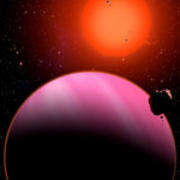
Astronomers at the Harvard-Smithsonian Center for Astrophysics have discovered a planet somewhat larger and more massive than Neptune orbiting a star 120 light-years from Earth. While Neptune has a diameter 3.8 times that of Earth and a mass 17 times Earth's, the new world (named HAT-P-11b) is 4.7 times the size of Earth and has 25 Earth masses.
HAT-P-11b was discovered because it passes directly in front of (transits) its parent star, thereby blocking about 0.4 percent of the star's light. This periodic dimming was detected by a network of small, automated telescopes known as "HATNet," which is operated by the Center in Arizona and Hawaii. HAT-P-11b is the 11th extrasolar planet found by HATNet, and the smallest yet discovered by any of the several transit search projects underway around the world.
Read the Center for Astrophysics press release.